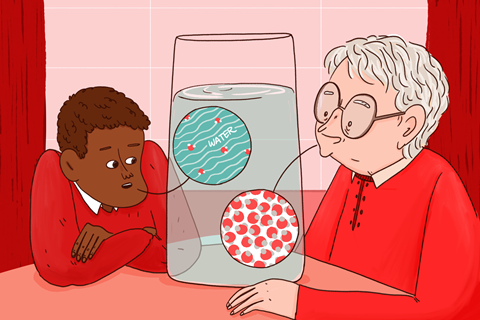Presenting students with conflicting evidence will help them unpick their misconceptions and construct new ideas
Students come into the classroom with their own understanding of how the world works. These self-constructed ideas can be in conflict with current scientific understanding and need challenging. You can do this by providing students with conflicting evidence.
Identifying and challenging misconceptions
Ideas from daily life experiences such as sensory experiences can often be in conflict with scientific ideas taught in the classroom. These ‘real life’ ideas are often strong and need challenging in the classroom for learning to progress. The first stage to challenging any misconceptions is to identify them, itself a challenge for teachers.
7 simple rules to boost science teaching
Click to expand and explore the rules
Build on the ideas that pupils bring to lessons
Help pupils direct their own learning
Use models to support understanding
Support pupils to retain and retrieve knowledge
- Pay attention to cognitive load—structure tasks to limit the amount of new information pupils need to process
- Revisit knowledge after a gap to help pupils retain it in their long-term memory
- Provide opportunities for pupils to retrieve the knowledge that they have previously learnt
- Encourage pupils to elaborate on what they have learnt
Use practical work purposefully and as part of a learning sequence
Develop scientific vocabulary and support pupils to read and write about science
Use structured feedback to move on pupils’ thinking
The next step is to unpick these false ideas. You can do this through cognitive conflict, for example by providing new information that directly contradicts students’ beliefs, then allowing them to revisit and reconstruct their ideas to accept the new theory. Any school that has taken part in or used Let’s Think resources will be familiar with this.
There are lots of ways we can challenge preconceptions in the classroom. As well as the two specific examples below, you can find more by following the links in this article.
Example 1: Particle diagrams
The particle model is a concept that students are usually familiar with but they often add their own interpretation, forming the basis of misconceptions around the model. For example, asking students to draw the particles found in a liquid such as water will often result in a diagram, where students draw the water particles and then colour the ‘water’ between the molecules blue. When challenged, students explain it’s the water the particles float in.

Another example is the commonly used particle model of a gas. If asked what is between the gas particles, students may respond with another substance, such as air. You can create cognitive conflict around this by showing that a blocked syringe containing gas can be compressed into a smaller volume, but one containing a liquid or solid cannot. This challenges their current thinking and allows them to link it to the particle model with which they are familiar.
Understanding can further be challenged and extended by presenting students with different diagrams and asking them to discuss which is the most accurate and why.
Both the Royal Society of Chemistry’s Learn Chemistry and STEM have great resources for teaching the particle model, common misconceptions and use of models in teaching this subject.
Download a group work exercise around debating the structure of metals as MS Powerpoint or pdf, and a worksheet to to challenge students’ preconceptions as MS Word or pdf.
Example 2: Metals and non-metals
It can be very difficult to shift thinking that seems logical or has been held onto for a long time. A simple example may be that metals are colder than non-metals – we touch metals, they feel colder. Therefore they must have a lower temperature. Simply providing a tray of different objects such as metal blocks, books, wooden spoons and teaspoons for students to touch and discuss can often draw out misconceptions about temperature and materials’ abilities to conduct heat.
To take this further, ask students to place ice cubes on a block of metal and a block of wood. If the metal is colder, why does the ice cube on the metal melt faster? You might find the excellent resources produced by STEM in collaboration with Salters and the University of York useful here, particularly this video.
Making it work in the classroom
It’s not easy to provide students with appropriate cognitive challenge. They need a safe environment in which to share their current ideas and to construct new ones. Some students may struggle with more abstract concepts. You need to manage group work effectively; the STEM website offers useful advice on meaningful group chat. Build time into the curriculum to revisit misconceptions and new ideas. Many misconceptions are commonplace among students, and you can address these by building them into your scheme of work. It may seem time consuming but successfully challenging preconceptions and misconceptions can lead to big gains in student learning.
This article is part of the series 7 simple rules for science teaching, developed in response to the EEF’s Improving secondary science guidance. It supports rule 1b, Develop pupils' thinking through cognitive conflict and discussion.
Downloads
Debating metal bonding
PowerPoint, Size 0.15 mbDebating metal bonding
PDF, Size 67.98 kbConflict grid
Word, Size 0.34 mbConflict grid
PDF, Size 32.11 kb










No comments yet